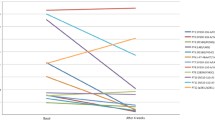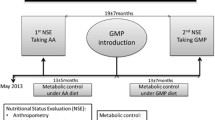Abstract
Objectives
A lifelong phenylalanine-restricted diet with supplementation of a phenylalanine-free amino acid formula is recommended in patients with phenylketonuria (PKU). The effect of a long-term PKU diet on renal function and blood pressure has not been investigated yet.
Design
We analyzed renal function in 67 patients with PKU, aged 15–43 years, by measuring glomerular filtration rate (GFR) and effective renal plasma flow by isotope clearance (51Cr-EDTA, 123J-Hippuran), estimated GFR, blood retention parameters, urinary protein and electrolyte excretion. Renal ultrasound and 24 h ambulatory blood pressure monitoring were performed additionally. Patients were divided into three groups according to their: 1) current diet (CD), i.e., daily protein intake: ICD <0.8 g/kg, IICD 0.8–1.04 g/kg, IIICD >1.04 g/kg; 2) life-long diet time (LDT), i.e., cumulative years of life in which daily protein intake exceeded dietary recommendations: ILDT <15 years, IILDT 15–19 years, IIILDT >19 years.
Results
GFR was decreased in 19 % of the patients. With increasing protein intake, GFR decreased significantly (ICD 111 ml/min; IICD 105 ml/min; IIICD 99 ml/min. ILDT 112 ml/min; IILDT 103 ml/min; IIILDT 99 ml/min). Proteinuria was detected in 31 %, microalbuminuria in 7 %, and hypercalciuria in 23 % of the patients. 23 % of the patients had arterial hypertension, and 41 % revealed a nocturnal non-dipping status.
Conclusions
In patients with PKU on a lifelong diet we could detect impaired renal function in 19 %, proteinuria in 31 %, and arterial hypertension in 23 %. Thus, chronic kidney disease may develop in PKU patients, and routine renal function tests should be performed during long-term follow-up.





Similar content being viewed by others
Abbreviations
- AA:
-
Amino acids
- ABPM:
-
Ambulatory blood pressure monitoring
- BMI:
-
Body mass index
- BP:
-
Blood pressure
- CD:
-
Current diet
- CKD:
-
Chronic kidney disease
- eGFR:
-
Estimated glomerular filtration rate
- ERPF:
-
Effective renal plasma flow
- GFR:
-
Glomerular filtration rate
- LDT:
-
Life-long diet time
- PAH:
-
Phenylalanine hydroxylase
- Phe:
-
Phenylalanine
- PKU:
-
Phenylketonuria
- RDA:
-
Recommended daily allowance
References
Acosta PB (1996) Recommendations for protein and energy intakes by patients with phenylketonuria. Eur J Pediatr 155(Suppl 1):S121–S124
Acosta PB, Yannicelli S, Marriage B et al (1998) Nutrient intake and growth of infants with phenylketonuria undergoing therapy. J Pediatr Gastroenterol Nutr 27:287–291
Acosta PB, Yanicelli S, Singh R et al (2003) Nutrient intakes and physical growth of children with phenylketonuria undergoing nutrition therapy. J Am Diet Assoc 103:1167–1173
Anderson PH, O’Loughlin PD, May BK, Morris HA (2004) Determinants of circulating 1,25-dihydroxyvitamin D3 levels: the role of renal synthesis and catabolism of vitamin D. J Steroid Biochem Mol Biol 89–90:111–113
Arnold GL, Vladutiu CJ, Kirby RS, Blakely EM, Deluca JM (2002) Protein insufficiency and linear growth restriction in phenylketonuria. J Pediatr 141:243–246
Bernstein AM, Treyzon L, Li Z (2007) Are high-protein, vegetable based diets safe for kidney function? A review of the literature. J Am Diet Assoc 107:644–650
Blecker S, Matsushita K, Köttgen A et al (2011) High-normal albuminuria and risk of heart failure in the community. Am J Kidney Dis 58:47–55
Brenner BM, Meyer TW, Hostetter TH (1982) Dietary protein intake and the progressive nature of kidney disease. N Engl J Med 307:652–659
Brenner BM, Lawler EV, Mackenzie HS (1996) The hyperfiltration theory: a paradigm shift in nephrology. Kidney Int 49:1774–1777
Burgard P, Bremer HJ, Bührdel P et al (1999) Rationale for the German recommendations for phenylalanine level control in phenylketonuria 1997. Eur J Pediatr 158:46–54
Chaturvedi S, Jones C (2007) Protein restriction for children with chronic renal failure. Cochrane Database Syst Rev 17(4):CD006863
DGE Empfehlung: Deutsche Gesellschaft für Ernährung (1985) Empfehlungen für die Nährstoffzufuhr: Umschau Verlag
DGE Empfehlung: Deutsche Gesellschaft für Ernährung (1991) Empfehlungen für die Nährstoffzufuhr: Umschau/Braus
D-A-CH Empfehlung: Deutsche Gesellschaft für Ernährung, Österreichische Gesellschaft für Ernährung, Schweizerische Gesellschaft für Ernährungsforschung, Schweizerische Vereinigung für Ernährung (2000) Referenzwerte für die Nährstoffzufuhr: Umschau/Braus
Enomoto A, Niwa T (2007) Roles of organic anion transporters in the progression of chronic renal failure. Ther Apher Dial 11(Suppl 1):S27–S31
Fouque D, Aparicio M (2007) Eleven reasons to control the protein intake of patients with chronic kidney disease. Nat Clin Pract Nephrol 3:383–392
German Nutrition Society (2012) New reference values for vitamin D. Ann Nutr Metab 60:241–246
Gropper SS, Gropper DM, Acosta PB (1993) Plasma amino acid response to ingestion of L-amino acids and whole protein. J Pediatr Gastroenterol Nutr 16:143–150
Guldberg P, Rey F, Zschocke J et al (1998) A European multicenter study of phenylalanine hydroxylase deficiency: classification of 105 mutations and a general system for genotype-based prediction of metabolic phenotype. Am J Hum Genet 63:71–79
Güttler F, Guldberg KF (1994) Mutations in the phenylalanine hydroxylase gene: genetic determinants for the phenotypic variability of hyperphenylalaninemia. Acta Paediatr 407(Suppl):46–56
Guy M, Borzomato JK, Newall RG, Kalra PA, Price CP (2009) Protein and albumin-to-creatinine ratios in random urines accurately predict 24 h protein and albumin loss in patients with kidney disease. Ann Clin Biochem 46:468–476
Halbesma N, Bakker SJ, Jansen DF et al (2009) High protein intake associates with cardiovascular events but not with loss of renal function. J Am Soc Nephrol 20:1797–1804
Hennermann JB, Vetter B, Wolf C et al (2000) Phenylketonuria and hyperphenylalaninemia in Eastern Germany: a characteristic molecular profile and 15 novel mutations. Hum Mut 15:254–260
Hoeksma M, Van Rijn M, Verkerk PH et al (2005) The intake of total protein, natural protein and protein substitute and growth of height and head circumference in Dutch infants with phenylketonuria. J Inherit Metab Dis 28:845–854
Hüseman D, Gellermann J, Vollmer I et al (1999) Long-term prognosis of hemolytic uremic syndrome and effective renal plasma flow. Pediatr Nephrol 13:672–677
Itoh R, Nishiyama N, Suyama Y (1998) Dietary protein intake and urinary excretion of calcium: a cross-sectional study in a healthy Japanese population. Am J Clin Nutr 67:438–444
Jia Y, Hwang SY, House JD, Ogborn MR, Weiler HA, Karmin O, Aukema HM (2010) Long-term high intake of whole proteins results in renal damage in pigs. J Nutr 140: 1646–1652
Kambham N, Markowitz GS, Valeri AM (2001) Obesity-related glomerulopathy: an emerging epidemic. Kidney Int 59:1498–1509
Kastarinen H, Vasunta RL, Ukkola O, Kesäniemi YA (2010) Glomerular filtration rate is related to dipping pattern in ambulatory blood pressure monitoring—a cross-sectional population-based study. J Hum Hypertens 24:247–253
King AJ, Levey AS (1993) Dietary protein and renal function. J Am Soc Nephrol 3:1723–1737
Kooman JP (2009) Estimation of renal function in patients with chronic kidney disease. J Magn Reson Imaging 30:1341–1346
Krauch G, Müller E, Anninos A, Bremer HJ (1996) Comparison of the protein quality of dietetically treated phenylketonuria patients with the recommendations of the WHO expert consultation. Eur J Pediatr 155(Suppl 1):S153–S157
Kriz W (2004) Podocytes as a target for treatment with ACE inihibitors and/or angiotensin-receptor blockers. Kidney Int 65:333–334
Lichter-Konecki U, Hipke CM, Konecki DS (1999) Human phenylalanine hydroxylase gene expression in kidney and other nonhepatic tissues. Mol Genet Metab 67:308–316
MacDonald A, Rocha JC, van Rijn M, Feillet F (2011) Nutrition in phenylketonuria. Mol Genet Metab 104(Suppl):S10–S18
Manz F, Schmidt H, Schärer K, Bickel H (1977) Acid-base status in dietary treatment of phenylketonuria. Pediatr Res 11:1084–1087
Mönch E, Herrmann ME, Brösicke H, Schöffer A, Keller M (1996) Utilisation of amino acid mixtures in adolescents with phenylketonuria. Eur J Pediatr 155(Suppl 1):S115–S120
O’Brien E, Asmar R, Beilin L et al (2005) Practice guidelines of the European Society of Hypertension for clinic, ambulatory and self blood pressure measurement. J Hypertens 23:697–701
Parati G, Pickering TG (2009) Home blood-pressure monitoring: US and European consensus. Lancet 373:876–878
Ribas GS, Sitta A, Wajner M, Vargas CR (2011) Oxidative stress in phenylketonuria: what is the evidence? Cell Mol Neurobiol 31:653–662
Schena FP (2011) Management of patients with chronic kidney disease. Intern Emerg Med 6(Suppl 1):77–83
Schwartz GJ, Muñoz A, Schneider MF et al (2009) New equations to estimate GFR in children with CKAD. J Am Soc Nephrol 20:629–637
Scriver CR, Kaufman S (2001) Phenylalanine hydroxylase deficiency. In Scriver CR, Beaudet AL, Sly W, Valle D, Childs B, Vogelstein B (eds). The metabolic and molecular basis of inherited disease. McGraw-Hill, 1667–1724
Sirtori LR, Dutra-Filho CS, Fitarelli D et al (2005) Oxidative stress in patients with phenylketonuria. Biochim Biophys Acta 1740:68–73
Sitta A, Barschak AG, Deon M et al (2009) L-Carnitine blood levels and oxidative stress in treated phenylketonuric patients. Cell Mol Neurobiol 29:211–218
Staples A, LeBlond R, Watkins S, Wong C, Brandt J (2010) Validation of the revised Schwartz estimating equation in a predominantly non-CKD population. Pediatr Nephrol 25:2321–2326
White JE, Kronmal RA, Acosta PB (1982) Excess weight among children with phenylketonuria. J Am Coll Nutr 1:293–303
Wingen AM, Fabian-Bach C, Mehls O (1997) Randomised multicentre study of a low-protein diet on the progression of chronic renal failure in children. European study group of nutritional treatment of chronic renal failure in childhood. Lancet 349:1117–1123
Wühl E, Witte K, Soergel M, Mehls O, Schaefer F (2002) German working group on pediatric hypertension: distribution of 24-h ambulatory blood pressure in children: normalized reference values and role of body dimensions. J Hypertens 20:1995–2007
Zager RA, Johannes G, Tuttle SE, Sharma HM (1983) Acute amino acid nephrotoxicity. J Lab Clin Med 101:130–140
Zhang QL, Rothenbacher D (2008) Prevalence of chronic kidney disease in population-based studies: systematic review. BMC Publ Health 8:117
Zhao YY, Liu J, Cheng XL, Bai X, Lin RC (2012) Urinary metabonomics study on biochemical changes in an experimental model of chronic renal failure by adenine based on UPLC Q-TOF/MS. Clin Chim Acta 413:642–649
Acknowledgement
We thank all patients and their parents for the participation and for their cooperation. We are grateful to Christine Gebauer and Gudrun Heide who calculated dietary protocols and dietary protein intake of all patients included in the study.
Conflict of interest
None.
Author information
Authors and Affiliations
Corresponding author
Additional information
Communicated by: Eva Morava
Eberhard Mönch and Uwe Querfeld both authors contributed equally to the study.
Rights and permissions
About this article
Cite this article
Hennermann, J.B., Roloff, S., Gellermann, J. et al. Chronic kidney disease in adolescent and adult patients with phenylketonuria. J Inherit Metab Dis 36, 747–756 (2013). https://doi.org/10.1007/s10545-012-9548-0
Received:
Revised:
Accepted:
Published:
Issue Date:
DOI: https://doi.org/10.1007/s10545-012-9548-0




